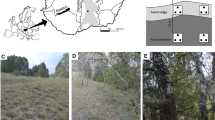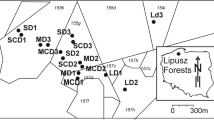Abstract
Natural regeneration of windthrow areas is an important issue when planning forestry measures after forest disturbances. Seedling recruitment was investigated in storm-damaged hemiboreal mixed forests in eastern Estonia. The establishment and growth of seedlings from natural regeneration was registered for tree species in soil pits and in mounds of uprooted trees in stands that were either heavily or moderately damaged. Seedling growth is expected to be better in large but shallow soil pits created by uprooted Norway spruce [Picea abies (L.) Karst.] and poorer in small but deep pits created by the hardwoods in the area, silver birch (Betula pendula Roth.) and European aspen (Populus tremula L.). The most abundant regenerating species was birch. Pits hosted larger seedling numbers than mounds, due to soil instability in mounds. Rowan (Sorbus aucuparia L.) showed significantly faster growth than the other seedling species. Norway spruce pits were preferred to pits of other species by both birch and spruce seedlings. Black alder [Alnus glutinosa (L.) J. Gaertn.] did not show a preference for pits of a certain species of uprooted tree. Both spruce and rowan preferred hardwood mounds over spruce mounds. Storm severity also affected species composition: birch predominantly occurred on pits and mounds in heavily disturbed areas, while spruce was more abundant in the moderately damaged areas. The effects of advance regeneration and surrounding stands on seedling microsite preferences should be considered in future research and subsequent management recommendations.






Similar content being viewed by others
References
Beatty SW, Stone EL (1986) The variety of soil microsites created by tree falls. Can J For Res 16:539–548
Bell FW, Ter-Mikaelian MT, Wagner RG (2000) Relative competitiveness of nine early-successional boreal forest species associated with planted jack pine and black spruce seedlings. Can J For Res 30:790–800
Blennow K, Olofsson E (2008) The probability of wind damage in forestry under a changed wind climate. Clim Change 87:347–360
Boose ER, Foster DR, Fluet M (1994) Hurricane impacts to tropical and temperate forest landscapes. Ecol Monogr 64:369–400
Calogeropoulos C, Greene DF, Messier C, Brais S (2004) The effect of harvest intensity and seedbed type on germination and cumulative survivorship of white spruce and balsam fir in northwestern Quebec. Can J For Res 34:1467–1476
Canham CD, Papaik MJ, Latty EF (2001) Interspecific variation in susceptibility to windthrow as a function of tree size and storm severity for northern temperate tree species. Can J For Res 31:1–10
Carlton GC, Bazzaz FA (1998) Regeneration of three sympatric birch species on experimental hurricane blowdown microsites. Ecol Monogr 68:99–120
de Chantal M, Granström A (2007) Aggregations of dead wood after wildfire act as browsing refugia for seedlings of Populus tremula and Salix caprea. For Ecol Manage 250:3–8
Elliott KJ, Hitchcock SL, Krueger L (2002) Vegetation response to large-scale disturbance in a Southern Appalachian forest: Hurricane Opal and salvage logging. J Torrey Bot Soc 129:48–59
Ennos AR (1997) Wind as an ecological factor. Trends Ecol Evol 12:108–111
Everham EM, Brokaw NVL (1996) Forest damage and recovery from catastrophic wind. Bot Rev 62:113–185
Foster DR (1988) Disturbance history, community organization and vegetation dynamics of the old-growth Pisgah forest, South-Western New Hampshire. USA J Ecol 76:105–134
Harrington TB, Bluhm AA (2001) Tree regeneration responses to microsite characteristics following a severe tornado in the Georgia Piedmont, USA. For Ecol Manage 140:265–275
Ilisson T, Metslaid M, Vodde F, Jõgiste K, Kurm M (2005) Storm disturbance in forest ecosystems in Estonia. Scan J For Res 20(Suppl 6):88–93
Ilisson T, Metslaid M, Vodde F, Jõgiste K, Kurm M (2006) Vascular plant response to windthrow severity in Norway spruce-dominated Myrtillus site type forests in Estonia. Ecoscience 13:193–202
Ilisson T, Köster K, Vodde F, Jõgiste K (2007) Regeneration development 4–5 years after a storm in Norway spruce dominated forests, Estonia. For Ecol Manage 250:17–24
Kangur A, Korjus H, Jõgiste K, Kiviste A (2005) A conceptual model of forest stand development based on permanent sample-plot data in Estonia. Scan J For Res 20(Suppl 6):94–101
Kohv K, Liira J (2005) Anthropogenic effects on vegetation structure of the boreal forest in Estonia. Scan J For Res 20(Suppl 6):122–134
Krueger L, Peterson CJ (2006) Effects of white-tailed deer on Tsuga canadensis regeneration: evidence of microsites as refugia from browsing. Am Midl Nat 156:353–362
Kubota Y (1995) Effects of disturbance and size structure on the regeneration process in a sub-boreal coniferous forest, northern Japan. Ecol Res 10:135–142
Kubota Y, Konno Y, Hiura T (1994) Stand structure and growth patterns of understorey trees in a coniferous forest, Taisetsuzan National Park, northern Japan. Ecol Res 9:333–341
Kuuluvainen T (1994) Gap disturbance, ground microtopography, and the regeneration dynamics of boreal coniferous forests in Finland: a review. Ann Zool Fenn 31:35–41
Kuuluvainen T, Juntunen P (1998) Seedling establishment in relation to microhabitat variation in a windthrow gap in a boreal Pinus sylvestris forest. J Veg Sci 9:551–562
Kuuluvainen T, Kalmari R (2003) Regeneration microsites of Picea abies seedlings in a windthrow area of a boreal old-growth forests in Finland. Ann Bot Fenn 40:401–413
Lilja-Rothsten S, de Chantal M, Peterson C, Kuuluvainen T, Vanha-Majamaa I, Puttonen P (2008) Microsites before and after restoration in managed Picea abies stands in southern Finland: effects of fire and partial cutting with dead wood creation. Silva Fennica 42:165–176
Lindenmayer DB, Foster DR, Franklin JF, Hunter ML, Noss RF, Schmiegelow FA, Perry D (2004) Salvage harvesting after natural disturbance. Science 303:1303
Lõhmus E (2004) Estonian forest site types (in Estonian: Eesti metsakasvukohatüübid). Eesti Loodusfoto, Tartu
Maher EL, Germino MJ (2006) Microsite differentiation among conifer species during seedling establishment at alpine treeline. Ecoscience 13:334–341
Moora M, Daniell TJ, Kalle H, Liira J, Püssa K, Roosaluste E, Öpik M, Wheatley R, Zobel M (2007) Spatial pattern and species richness of boreonemoral forest understorey and its determinants—a comparison of differently managed forests. For Ecol Manage 250:64–70
Nelson JL, Groninger JW, Battaglia LL, Ruffner CM (2008) Bottomland hardwood forest recovery following tornado disturbance and salvage logging. For Ecol Manage 256:388–395
Nicoll BC, Gardiner BA, Rayner B, Peace AJ (2006) Anchorage of coniferous trees in relation to species, soil type, and rooting depth. Can J For Res 36:1871–1883
Nilson A, Kiviste A, Korjus H, Mihkelson S, Etverk I, Oja T (1999) Impact of recent and future climate change on Estonian forestry and adaptation tools. Clim Res 12:205–214
Noguchi M, Yoshida T (2004) Tree regeneration in partially cut conifer-hardwood mixed forests in northern Japan: roles of establishment substrate and dwarf bamboo. For Ecol Manage 190:335–344
Peterson CJ (2004) Within-stand variation in windthrow in southern boreal forests of Minnesota: is it predictable? Can J For Res 34:365–375
Peterson CJ, Leach AD (2008) Salvage logging after windthrow alters microsite diversity, abundance and environment, but not vegetation. Forestry 81:361–376
Peterson CJ, Pickett STA (1990) Microsite and elevational influences on early forest regeneration after catastrophic windthrow. J Veg Sci 1:657–662
SAS Institute Inc. (1999) SAS OnlineDoc. (version 8). SAS Institute Inc., Cary
Schelhaas M-J, Nabuurs G-J, Schuck A (2003) Natural disturbances in the European forests in the 19th and 20th centuries. Glob Chang Biol 9:1620–1633
Schlyter P, Stjernquist I, Barring L, Jonsson AM, Nilsson C (2006) Assessment of the impacts of climate change and weather extremes on boreal forests in northern Europe, focusing on Norway spruce. Clim Res 31:75–84
Stanturf JA, Goodrick SL, Outcalt KW (2007) Disturbance and coastal forests: a strategic approach to forest management in hurricane impact zones. For Ecol Manage 250:119–135
Sugita H, Nagaike T (2005) Microsites for seedling establishment of subalpine conifers in a forest with moss-type undergrowth of Mt. Fuji, central Honshu, Japan. Ecol Res 20:678–685
Ulanova NG (2000) The effects of windthrow on forest at different spatial scales: a review. For Ecol Manage 135:155–167
Wohlgemuth T, Kull P, Wüthrich H (2002) Disturbance of microsites and early tree regeneration after windthrow in Swiss mountain forests due to the winter storm Vivian 1990. For Snow Landscape Res 77:17–48
Zobel M, Kalamees R, Püssa K, Roosaluste E, Moora M (2007) Soil seed bank and vegetation in mixed coniferous forest stands with different disturbance regimes. For Ecol Manage 250:71–76
Acknowledgments
We thank two anonymous reviewers for their valuable comments. This study was supported by grants from the Estonian Environmental Investment Fund, Estonian Ministry of Education and Science grant SF0170014s08, Metsämiesten Säätiö Foundation, and Prins Bernhard Cultuurfonds.
Author information
Authors and Affiliations
Corresponding author
About this article
Cite this article
Vodde, F., Jõgiste, K., Gruson, L. et al. Regeneration in windthrow areas in hemiboreal forests: the influence of microsite on the height growths of different tree species. J For Res 15, 55–64 (2010). https://doi.org/10.1007/s10310-009-0156-2
Received:
Accepted:
Published:
Issue Date:
DOI: https://doi.org/10.1007/s10310-009-0156-2




